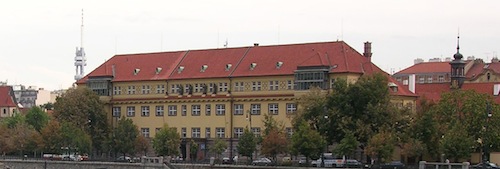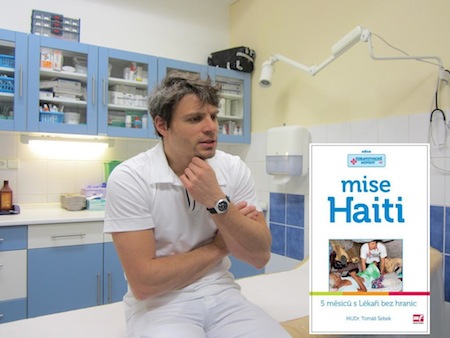On the bank of the Vltava River, within walking distance from the city centre, is the oldest medical centre in the Czech Republic whose name is associated with great personalities that since the very beginning supported its development
Thanks to a recent initiative, the hospital aims to become an even more valuable reference point for foreign residents and tourists
The St. Francis Hospital (Hospital Na Františku) in Prague, situated on the right bank of the Vltava river, has provided health care since the fourteenth century. Few institutions, not only in Czech Republic but all over Europe, have had a similar tradition.
Its uniqueness has various causes. First of all, it is the oldest hospital in the Country. It was Bohuslav of Olbramovice, a rich exponent of the Prague bourgeoisie who, in 1354, founded a hospital for the poor, known as “špitál Bohuslavův”, the hospital of Bohuslav. It was built in the vicinity of the Gothic chapel of St. Simon and Judas, consecrated by the Prague Bishop Arnošt of Pardubice. Transformed in the eighteenth century into an early-Baroque church suitable for hospital services, it is still inside the complex and hosts concerts.
Secondly, the name of the hospital is linked to the great historical figures that from the very beginning favoured its development. In 1620, Emperor Ferdinand II gave it to the Hospitaller Order of St. John of God, the Brothers, for supporting him in the White Mountain Battle, or perhaps, according to what they say, because he was grateful to one of them for saving his injured hand – whereas his doctor wanted to amputate it. Putting into practice the motto Per corpus ad animam, the brothers took care of the sick, whilst the most suitable were sent to study medicine at university. However, they limited the amount of care to male patients and built a pharmacy where they prepared decoctions and ointments.

(St. Francis Hospital on the waterfront Dvořákovo nábřeží)
Centuries of transformations and pre-eminence
The hospital was expanded and modified several times over the centuries. After the Thirty years’ war, Count Černín funded its north extension, but in 1689, a fire damaged this new construction. In 1703, a donation from Empress Maria Theresa allowed the building to grow upwards by adding a floor. The availability of space increased rapidly until it was able to accommodate 90 patients compared to the initial twenty or so, or 55 patients in 1620, to become the largest hospital in Prague. The administrative precision of that period was quite astonishing. We know for example that up to 1714 the average age of patients was 26, that the most frequent diagnosis was fever and the cause of death oedema. During the mid-eighteenth century, work on the exterior facade was completed, where now there are some statues of saints and which is largely still intact to this day, with a series of other Baroque elements: the staircase called Miserere, the cross-shaped corridors, the sundial or the eight lobes fountain situated in the internal courtyard. In 1908 the Emperor Franz Joseph visited the hospital and offered financial support to the institution. Shortly after Masaryk, Beneš and Pope Pius XI collected a large sum for the huge work carried out in the nineteen-twenties. The new hospital was built consisting of a simple structure in the shape of an inverted E, with the main facade and entrance looking out towards the river. The hospital could thus accommodate one hundred patients more, thus becoming the largest health facility in Prague and its neighbourhood, with modern operating rooms and equipment.
Finally, the St. Francis Hospital became the background to important moments in the history of medicine. In 1685 Professor Sebastian Kristian Zeidler carried out the first autopsy demonstration. In the eighteenth century the institute became a sound scientific and research centre that attracted renowned experts such as Josef Plenciz, Antonín Sebald and Karel Arnold, under whose direction medical students could gain practical experience working close to patients. It was a revolutionary step forward and the start of a collaboration with the Faculty of Medicine. In 1783 first clinic for the mentally ill was opened and Jan Theobald Held was appointed director of the hospital and it was here that he cured Josef Dobrovský, the historical father of Slavic Studies on Czech land.
Among the other famous hospital patients there was Václav Havel, who was hospitalized here during the regime after one of his prison detention periods.
In 1847 the surgeon Celestýn Opitz made the first surgical operation under general anaesthesia of the Austro-Hungarian empire and of all Europe, an intervention which was celebrated with a plaque placed on the facade of the building. Another important date is 1965, when the first intensive care unit of Czechoslovakia was opened.
During the Second world war, St. Francis Hospital served as a military hospital for the pilots of the German Luftwaffe. In 1945 the Brothers resumed their activity and tried to include the structure into the health care system that was developing in the post-war period, but in the 1950s the hospital was eventually integrated into the socialist health care system.
After the Velvet Revolution, it continued to be an efficient structure increasingly more suitable to meet the standards of modern medicine and since 1992 it has been managed by the City of Prague 1.
A large restructuring took place which has affected the entire building: all the surgeries and all wards were equipped with advanced equipment. The roof and the boiler room were replaced, the kitchen rebuilt, as well as the intensive care unit, ambulance reception area situated inside the courtyard. A great deal was invested by the municipality for this structure on the banks of the Vltava river, but unfortunately, proximity to the river has had its downside: the flood of 2002 interrupted the work being done and meant that the ground floor and basement had to be subject to further heavy repair work. Even the flood of June 2013 forced the hospital to close down its activity for a few days and transfer patients to other facilities.

(The surgeon Tomáš Šebek and his book Mission to Haiti)
The recent medical consulting project for expats
The St. Francis Hospital has always been a reference point also for foreigners. Given its central location, it may happen that tourists or those living in Prague for business purposes require its service. Tomáš Šebek, a surgeon, had the idea recently of opening a medical service dedicated particularly to foreigners. To get to know a little more about the initiative, we met him at the hospital, where he is part of the medical team. Although only thirty-seven, Dr. Šebek has a vast experience: he works in the surgical ward and collaborated on international projects. He has worked for a year at the Dublin’s university hospital and participated in missions with Doctors Without Borders in Haiti and Afghanistan. He has written about his experiences in a book called “Mission to Haiti – Five months with Doctors Without Borders”, a narrative that traces the period he spent on a surgery project. “I used to update my blog daily with my experiences – Dr. Šebek explains. – My friends and acquaintances in the Czech Republic liked this diary so much and insisted that it should become a book”. The idea of opening a clinic for foreigners inside St. Francis Hospital came to me instead, because “for a year I had lived in Dublin as an expat – says Dr. Šebek, who takes care in person of English speaking patients. – I know from my own experience how difficult it is to understand a different type of health care system and choose the right doctor or at least to arrange the basic medical treatments. The Czech Health service is comparable to that of any Western country, but the system and the language barrier can be a serious limitation for foreigners”. To promote this initiative, in collaboration with Dr. Šebek, is also Sister Veritas, sister from the Congregation of St. Charles Borromeo, a nurse and psychologist who speaks fluent Italian. Our readers will remember her for the interview in which she described the time when she looked after President Václav Havel during his last months of life. For now, the clinic is open two hours a week and gives priority to an elective surgery cases, but the plan is to expand the team, involving experts in every branch of medicine. Of course, local citizens are already satisfied with the normal service afforded. As part of the competition “The best hospital in the year 2009”, St. Francis Hospital finished in second place at national level according to patients evaluations. A further confirmation that this hospital is undoubtedly noteworthy – on the Czech medical landscape – for its high-quality specialist assistance and skilled personnel.
by Sabrina Salomoni




